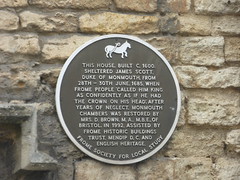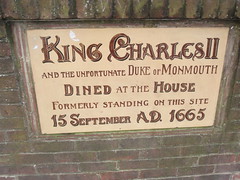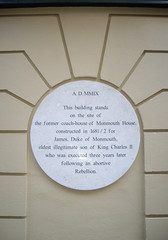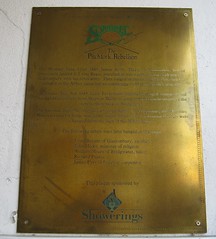James Scott


James Scott
(1649-1685)
1st Duke of Buccleuch (1663-1685), 1st Duke of Monmouth (1663-1685), 1st Earl of Doncaster (1663-1685), 467th Knight of the Order of the Garter (1663-1685), 1st Earl of Dalkeith (1663-1685), and 1st Baron Scott of Tindale (1663-1685)
Family tree
Commemorated on 5 plaques
This house, built c.1600, sheltered James Scott, Duke of Monmouth, from 28th-30th June, 1685, when Frome people 'called him King as confidently as if he had the crown on his head'. After years of neglect, Monmouth Chambers was restored by Mrs. D. Brown, M.A., M.B.E., of Bristol, in 1992. Assisted by Frome Historic Buildings Trust, Mendip D. C. and English Heritage.
Monmouth Chambers, Frome, United Kingdom where they sheltered (1685)
Following defeat at the Battle of Sedgemoor in 1685 The Duke of Monmouth was held in this house prior to his execution in the Tower of London
monmouth house, west street , Ringwood, United Kingdom where they was imprisoned (1685)
King Charles II and the unfortunate Duke of Monmouth dined at the house formerly standing on this site 15 September A.D. 1665
Sainsbury's Local, High Street, Poole, United Kingdom where they dined (1665)
A.D. MMIX This building stands on the site of the former coach-house of Monmouth House, constructed in 1681/2 for James, Duke of Monmouth, eldest illegitimate son of King Charles II, who was executed three years later following an abortive Rebellion.
9-11 Bateman’s Buildings, London, United Kingdom where they lived
On this site stood the medieval White Horse Inn. The pitchfork rebellion. On Monday June 22nd 1685 James Scott, Duke of Monmouth, having previously landed at Lyme Regis, marched in wet weather from Bridgewater to Glastonbury with his rebel army. They lodged in the two parish churches and camped in the Abbey ruins before continuing to Shepton Mallet next day. On Friday July 3rd 1695 Lord Feversham leading the royal troops passed through Glastonbury from Shepton Mallet to camp at Somerton in pursuit of the rebels, then back in Bridgewater. On Tuesday July 7th, the day after the Battle of Sedgemoor, the Wiltshire Militia leaving for home marched to Glastonbury where 6 unarmed rebels were hanged from the sign of the White Hart. the following rebels were later hanged in the town: Israel Bryant of Glastonbury, yeoman; John Hicks, minister of religion; William Meare of Bridgewater, tailor; Richard Pearce; James Pyes of Colyton, carpenter
Assembly Rooms, High Street, Glastonbury, United Kingdom where they was (1685)





